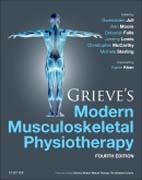
Grieve´s Modern Musculoskeletal Physiotherapy: Vertebral Column and Peripheral Joints
Jull, Gwendolen
Moore, Ann P.
Falla, Deborah
Lewis, Jeremy
McCarthy, Chris
Sterling, Michele
INDICE: Part 1 1. Introduction to text Part 2: Advances in theory and practice Section 2.1: Advances in Basic Science 2. The neurophysiology of pain and pain modulation: Modern pain neuroscience for musculoskeletal therapists 3. Neurophysiology of movement intro 3. Neuro-electrochemistry of movement 4. Postural control and sensorimotor integration 5. Motor control and motor learning 6. Interaction between pain & sensorimotor control 7. Neuromuscular adaptations to exercise 8. The peripheral nervous system 9. Functional Anatomy (A) The cervical and thoracic spines (B) The lumbar spine 10. Tendon and Tendinopathy (A) Tendon and Tendon Pathology (B) Managing Tendinopathies 11. Lifestyle and musculoskeletal health 12. Ageing and the musculoskeletal system Section 2.2: Advances in measurement methods 13. Movement analysis 14. New developments in ultrasound imaging in physiotherapy practice and research 15. Advances in Magnetic Resonance Imaging (MRI) Measures 16. Musculoskeletal Pain in the Human Brain: Insights From Functional Brain Imaging Techniques 17. Advances in measurement methods EMG 18. Non-invasive brain stimulation in the measurement and treatment of musculoskeletal disorders 19. Musculoskeletal modelling 20. Quantitative Sensory Testing: Implications for clinical practice 21. Outcome measures in musculoskeletal practice Section 2.3: Research approaches for musculoskeletal physiotherapy 22. Clinical Research to Test Treatment Effects (A) Classic multiple group parallel design randomized controlled trial (RCT) (B) The Cross-over Design, Diamond Design, Factorial Design and Fractional Factorial Design (C) Randomized Withdrawal and Expertise-based Designs (D) N-of-1 Trial Designs 23. Research methods in musculoskeletal Physiotherapy (A) Quantitative research (B) Qualitative Research (C) Approaches to research 24. Standardised data collection, audit and clinical profiling 25. Implementation research Part 3: Advances in clinical science and practice Section 3.1: Principles of management 26. Clinical reasoning and models for clinical management 27. Communicating with patients (A) Patient focused practice and communication: Use of communication in the clinical setting (B) Patient Education - a collaborative approach (C) Communicating risk 28. Pain management (A) The patient's pain experience (B) Physical interventions of pain management and potential processes (C) Educational approaches to pain management 29. Spinal Manipulation 30. Neurodynamic management of the peripheral nervous system 31. Therapeutic exercise: Clinical Prescription (A) Management of the sensorimotor system: The cervical region (B) Sensorimotor control of lumbar spine alignment (C) Management of the sensorimotor system: The lower limb 33. Consideration of cognitive and behavioural influences on physiotherapy practice 34. Adjunct modalities for pain (A) Electro physical agents (B) Acupuncture/dry needling (C) The use of tape in managing spinal pain 35. Cautions in Musculoskeletal Practice (A) Masqueraders (B) Haemodynamics and clinical practice (C) Pre-Manipulative Screening For CranioCervical Ligament Integrity Section 3.2: The broader scope of management 36. Supported self-management and overview of self-help 37. Role of physiotherapy in lifestyle and health promotion in musculoskeletal conditions 38. Musculoskeletal health in the workplace 39. Screening (A) Screening for musculoskeletal disorders (B)What Is Our Baseline for Movement? The Clinical Need for Movement Screening, Testing and Assessment 40. Advanced Roles in Musculoskeletal Physiotherapy Part 4: Overview of contemporary issues in practice Section 4.1: Introduction to section 41. Cervical spine: idiopathic neck pain 42. Whiplash Associated Disorders 43. Temporomandibular Disorders. Neuromusculoskeletal Assessment and Management 44. Thoracic spine: Models of assessment and management (A) Clinical Examination And Targeted Management Of Thoracic Musculoskeletal Pain (B) Model B (C) Management of the thoracic spine in patients with COPD 45. Lumbar spine (A) The McKenzie method of Mechanical Diagnosis and Therapy - an overview (B) Multi-dimensional classification system for Low Back Pain (C) Treatment based classification system (D) Movement System Impairment Syndromes of the Low Back (E) The role of motor control training 46. SI joint (Pelvic pain): Models of assessment and management (A) A person centred biopsychosocial approach to assessment and management of pelvic girdle pain (B) The Pelvic Girdle - a Look at how Time, Experience and Evidence Change Paradigms (C) A critical viewpoint on models, testing and treatment of patients with lumbopelvic pain 47. Hip-related pain 48. The Knee: (A) Acute knee injuries (B) Patellofemoral pain (C) Knee Osteoarthritis 49. Foot and ankle 50. The shoulder (A) Shoulder Assessment (B) Rotator Cuff Tendinopathy & Subacromial Pain Syndrome (C) The Unstable Shoulder (D) Posterior Shoulder Tightness (E) Frozen Shoulder Contraction Syndrome 51. Elbow 52. Wrist/hand Part 5: Future directions 53. Future directions in research and practice
- ISBN: 978-0-7020-5152-4
- Editorial: Churchill Livingstone
- Encuadernacion: Rústica
- Páginas: 720
- Fecha Publicación: 02/06/2015
- Nº Volúmenes: 1
- Idioma: Inglés
